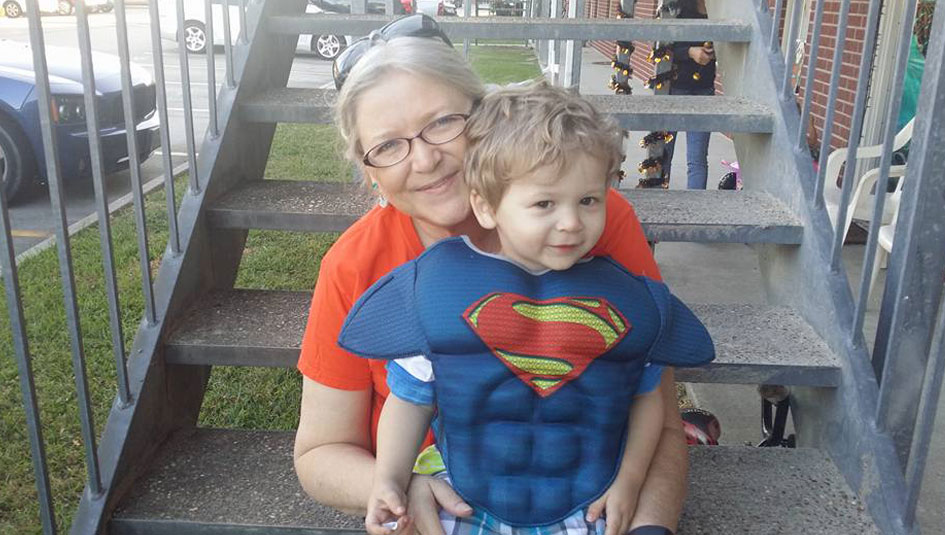When Diabetes Is Just One Branch of a Tree of Needs

This is the first in a three-part series on Type 1 diabetes and autism.
KJ Trahan’s son was a happy, sweet toddler. “Bean” exhibited some developmental delays and sensory issues, which resulted in his diet consisting of toddler formula even at 20 months of age. When he began to drink more and more, his parents became excited, thinking he was finally ready for solid foods.
In fact, Bean was showing signs of Type 1 diabetes. It wasn’t long before other behaviors developed. “He began to alternate vomiting and hitting himself in the face,” recalls Trahan. She interpreted the hitting as frustration with his illness, and she assured herself that he was staying hydrated, as evidenced by his wet diapers. But the morning of the third day, his skin turned gray, and he became lethargic. His parents took him to the emergency room, where they were bewildered to learn that his blood sugar was nearly 900 mg/dl.
“He was immediately flown to Children’s Hospital because – well, everyone knows the culprit of this story, DKA was killing him.”
But this wasn’t all. In treating his diabetes, the providers noticed behavioral red flags, so they assessed and referred Bean for more formal autism evaluation. That diagnosis came a few months later. His parents realize that they are lucky he survived, given their inability to recognize what was going on with their son physiologically. Hence, they celebrate his diaversery “not as the day he nearly died and would live forever after with a disability, but as the day his life was saved.”
For Trahan and other parents of children with both autism and Type 1 diabetes, the challenges can be enormous. The concurrent conditions compound each other and create further difficulties that may not be obvious to parents of a child with one or the other. One of the greatest struggles is communication. “Bean knows and can use words like ‘parallelogram’ and ‘telescope.’ He identifies animals and errant octagons he sees in nature. But he can’t use words to communicate his own feelings. Nor does he respond when you call his name.” Furthermore, the symptoms of highs and lows are not visible. “Only once has he ever broken out in a cold sweat, otherwise outwardly appearing the same at a glucose of 30 or 300 mg/dl.”
Before he obtained a continuous glucose monitor (CGM), Trahan tested her son round-the-clock because she had “had no way of knowing what was going on inside him.” Paying for the device is not easy. The family relies on Texas Medicaid assistance, which does not cover the device. (It is considered a luxury.) “We pay out of pocket now for CGM even though it costs as much as our mortgage,” says Trahan. They have no choice about the matter because Bean has to attend Head Start outside the home. “He needs to learn to talk and interact socially, it’s not optional.” His mother realizes that even the most vigilant teacher can’t be expected to understand his needs, given that he does not communicate. Not to mention, the classroom is full of other children.
Another difficulty? His sensory issues. “Bean cannot eat anything soft, mushy, or wet without gagging. He gags if I approach him with an empty spoon. Not just a little gag, he turns purple and makes croaking noises as he heaves.” He also takes food in and out of his mouth, rubbing it on his chin and chest. This behavior extends the duration of meals and makes it hard for his parents to quantify how many carbs were actually consumed.
Add to this the boy’s extreme pickiness. He prefers high-carb foods, such as breads and cereals, but does not take fast-acting carbs such as apple juice or icing. He is often unwilling to eat or drink on command. So, treating a low can be very difficult. “I try to be patient with him since his understanding of language is at a 14-month level, but it’s tough.” To protect against such situations, his parents “run him higher than most despite the long-term dangers of doing so.” Even with this habit, they’ve had to use mini glucagon many times.
“Like other families with autism, it is hard to find social support,” says Trahan. She originally turned to online groups, but found that she was constantly having to retell extensive background information only to face judgment from other users. “It’s exhausting to have to defend your every position when you’ve come to your supposed safe place.” In response to his being kept at a higher-than-normal glucose level, some mothers accused her of not caring for his well-being. They said she was “begging for complications down the road.” Others were critical of the frequency with which Bean has received mini glucagon, claiming that she should try harder for him to take icing or glucose tabs.
“I don’t venture outside the home very often because my husband works long hours to make up for the loss of second income, and I don’t have as many hands as I need to reign in the children.” In addition to Bean, she has two more children, one of whom also has autism and doesn’t communicate. “But we do need to eat and the walls close in sometimes, so now and then I take all the children grocery shopping or to play somewhere.”
She gets a lot of odd looks in public when strangers observe her force-feeding candy to her son. She recalls one particularly embarrassing incident involving a tantrum and food fight while visiting a McDonald’s play structure. Her son’s blood sugar was dropping, and he wouldn’t come out of the play place. So, Trahan had to climb in to get him and then urge him to eat ice cream. When he refused, she began negotiating with him to take fries, chocolate, anything. He kicked and screamed while the CGM alarmed. Finally, Trahan resigned to using a mini glucagon. (She only gets two a month, so has to be economical.) Throughout this entire fiasco, parents and other children stared. Both she and Bean were covered in ice cream and French fries, while Skittles were scattered across the floor.
When other parents hear stories like this, they suggest that she simply bring a friend along on public outings. “I don’t have any friends after being unable to nurture those relationships for the last three years,” says Trahan. Not to mention, her acquaintances are not willing to deal with two autistic children without language capabilities. Others have also suggested that she hire a helper. “With what money?” she asks. “We went from two incomes to one, and now we must pay for a CGM out of pocket. Sometimes there are no easy answers.”
What does medical care look like? “There is very little support for managing the interaction of autism and diabetes. The behavioral specialists don’t want to make recommendations outside their scope, and neither do the endocrinologists.” But Trahan is grateful to find support from both medical groups: “no one in the medical arena shames me for my choices, or for the fact we don’t have better control, or that I sometimes have to hold him down in public and give him a shot of glucagon.” These experts know it’s hard. Even if they can’t offer solutions, they are accepting of the situation and willing to listen.
Trahan has learned to cope with all of these struggles by recognizing her own and her son’s limits. Some activities are just not worth doing considering the amount of work involved. She thinks this runs counter to the philosophy of others in the diabetes community. “There is this sense that we need to feel like diabetes won’t stop you from doing anything in life. Sorry, but YES, there are limits with every disease.”
Her expectations for her child also set her apart from those in the diabetes community. “Many parents anguish over their diabetic children sensing that they are different than their peers, or they acutely mourn the normal life they lost. I worry that my child will never learn to call me Mom.”
Still, she tries not to compare herself and her son to others. “The saying goes, if you know a child with autism, you know ONE child with autism.” The same is true for diabetes, says Trahan. She advises other parents in similar situations to stay strong: “You are doing the best with what you have at this moment in time. Be kind to yourself. Do not tear down the biggest pillar of support that your child has.”
Do you have an idea you would like to write about for Insulin Nation? Send your pitch to submissions@insulinnation.com.
Thanks for reading this Insulin Nation article. Want more Type 1 news? Subscribe here.
Have Type 2 diabetes or know someone who does? Try Type 2 Nation, our sister publication.







